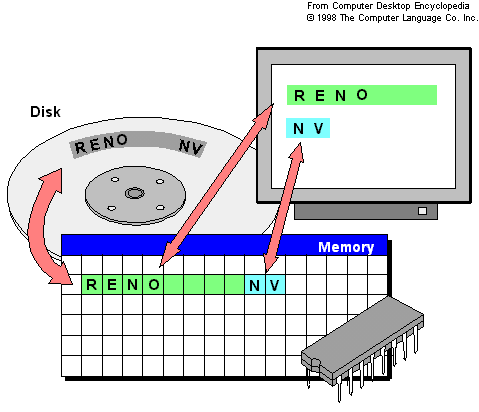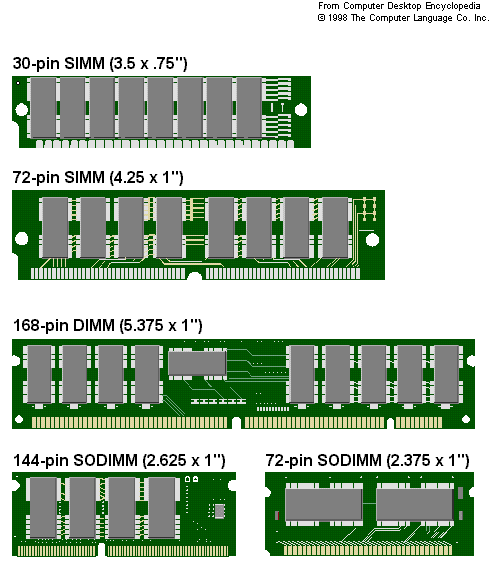
Memory
The computer's workspace (physically, a collection of RAM chips).

Each checkerboard square of memory holds one byte.The contents of any single byte or group of bytes can be calculated, compared and copied independently.That's how fields are put together to form records and broken apart when read back in. On the disk, data is stored in sectors, which hold a chunk of data (typically 512 bytes) and are the smallest unit that can be read or written.
Memory Doesn't Usually Remember Oddly enough, the computer's memory doesn't remember anything when the power is turned off. That's why you have to save your files before you quit your program. Although there are memory chips that do hold their content permanently (ROMs, PROMs, EPROMs, they're used for internal control purposes and not for the user's data. "Remembering" memory in a computer system is its disks and tapes, and although they are also called memory devices, many prefer to call them storage devices in order to differentiate them from internal memory.
Memory is such an important resource that it cannot be wasted. It must be allocated by the operating system as well as applications and then released when not needed. Errant programs can grab memory and not let go of it even when they are closed, which results in less and less memory available as you load and use more programs. If the operating system is not advanced, a malfunctioning application can write into memory used by another program, causing all kinds of unspecified behavior. You discover it when the system freezes or something weird happens all of a sudden.
Dynamic RAM - The most common type of computer memory, also called D-RAM ("dee-RAM") and DRAM. It usually uses one transistor and a capacitor to represent a bit. The capacitors must be energized hundreds of times per second in order to maintain the charges. Unlike firmware chips (ROMs, PROMs, etc.) both major varieties of RAM (dynamic and static) lose their content when the power is turned off.
SIMM - (Single In-line Memory Module) A narrow printed circuit board that holds memory chips. It plugs into a SIMM socket on the motherboard or memory board. The first SIMM format that became popular on personal computers was 3.5" long and used a 30-pin connector. A larger 4.25" format uses 72-pins and contains from one to 64 megabytes of RAM.

Although it's obvious that you have to put SIMMs in SIMM slots and DIMMs in DIMM slots, the memory chips must also be the same type (EDO, SDRAM, etc.) and the same or faster speed than your existing memory. In addition, your manual should show you all possible combinations of different-sized modules that can be used in the available memory slots. The 72-pin SIMMs and DIMMs are widely used in desktop computers and servers.
SODIMMs (Small Outline DIMMs) are used in laptops, while 30-pin SIMMs are typically found in older PCs.